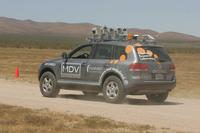A Different Kind Of Volkswagen - Stanley The Wonder Car
By Carey Russ
CLICK4 Stanley's Video(2:11)
Meet Stanley. Stanley is a 2004 Volkswagen Touareg. But Stanley is not like other 2004 Volkswagen Touaregs. Its not just that Stanley is powered by a 2.5-liter inline five-cylinder turbodiesel engine. There are plenty of so-equipped Touaregs in Europe, if not North America, so that's not the difference.
Look more closely at Stanley, moving down the road. There's nobody in the driver's seat.
Where other Volkswagens are driver's cars, Stanley, to be anthropomorphic, drives himself. No ``Drivers Wanted'' here, sorry humans. It's ``Drivers Not Required.'' Stanley is an autonomous vehicle, a robot. Stanley drives himself - there is no little man in a box, there is no remote control operator.
Stanley is the product of a cooperative venture between academia and industry. Academia is represented by the Palo Alto, CA-based Stanford University Engineering Department - hence the name ``Stanley. Industry is represented by Volkswagen and its Electronics Research Laboratory (ERL), venture capital firm Mohr Davidow Ventures (MDV), and Android, with further support from Intel, Honeywell, and visual imaging company Tyzx. In many ways, the team producing Stanley is a classic Silicon Valley start-up, with input from academia, existing companies, and venture capital. And all parties are located within close distance for optimum cooperation.
There is a long history of academic-industry partnership in the valley, with Stanford the premier university in the area. About 50 people from all of the partners come together as the Stanford Racing Team, an interdisciplinary group incorporating backgrounds in artificial intelligence, robotics, electrical engineering, mechanical engineering, and aerospace. There are and will be plenty of new developments in hardware and software involved.
``Racing Team'' suggests that there is a race involved. It is not your normal race. Stanley and the Stanford Racing Team exist to compete in the second DARPA Grand Challenge, set to take place on October 8, 2005. If the name DARPA seems familiar, it's a government agency, the Defense Advanced Research Projects Agency. Yes, military applications are a DARPA specialty, but some of those have interesting civilian spinoffs. One little project it was involved with in the past was an early computer network known as Darpanet, designed to link universities and defense contractors together. You may be more familiar with Darpanet's direct descendent - the Internet.
The goal of the Grand Challenge is a successful autonomous ground vehicle - one which can successfully drive without human intervention. Military applications should be obvious, but there are plenty of non-military uses as well. Planetary exploration, anyone? Closer to home, and one reason for Volkswagen's involvement, is the development of driver-assistance systems, for use in thick fog or whiteout snow or other inclement conditions.
The first Grand Challenge took place last year. Of 105 entries, none finished. None got further than eight miles. This year's course will be even more difficult, and will not be revealed in detail to participants beforehand. Surfaces will include both dirt and paved roads. Navigation, for Stanley, at least, is by a mixture of ``visual'' - optical, radar, and lidar (laser) - and GPS cues. The race will be run in Southern California's Mojave Desert. Anyone out there remember the ``Barstow-to-Vegas'' off-road motorcycle races of the past? Think Barstow-to-Vegas for robots. This is the 21st Century, after all. The winner, if there is one, will receive $2 million, but that's not the main motivation. New technology is.
Why is Volkswagen involved? As mentioned, there are plenty of civilian-use possibilities for technologies developed for the DARPA Grand Challenge. And VW has a long history of technological development. The Touareg is intrinsically-suited for autonomous operation, as all of its major systems are already electronically-controlled, and it is eminently capable of handling the conditions expected in the Grand Challenge and worse. And the Electronics Research Laboratory is within walking distance of the Stanford campus.
A little over a month ago, before the project was unveiled to the public, a group of journalists were introduced to the Stanford Racing Team and Stanley. It was a fascinating experience. I've met development engineers and I've ridden in experimental vehicles before, but this was a little different. While group leadership is composed of Stanford professors and VW engineers, the bulk of the work is being done by Stanford graduate students. To a man - and woman - they were bright, knowledgeable, enthusiastic, and having great time working on the project, and their degrees. And why not? This is the cutting edge.
Stanley ``sees'' the world with a mix of optical and electronic inputs, classifies the area ahead as ``road'' and ``not road,'' and learns from his mistakes. The control hardware is complex; the software even more so. Stanley is human-drivable, meaning that the steering wheel, shift linkage, and control pedals are hooked up in the normal fashion.
The highlight of the presentation was a chance to ride in Stanley, and view what he was seeing in real time via an engineer's laptop. A course was set out in a grassy area of the campus, I climbed in the back seat (all the better to see the laptop), and off we went. As would be the case with a live driver, each lap around the course was slightly different. The ``Stanley's-eye'' view was eerie, like looking at radar images. Which it was. A view of the world through the eyes of alien intelligence. It was also amusing to watch the steering wheel turn by itself.
The Stanford Racing Team has promised to keep journalists and the public updated in the time before the race, and I look forward to learning more about this fascinating project. For more information, check out http://www.stanfordracing.org/.



